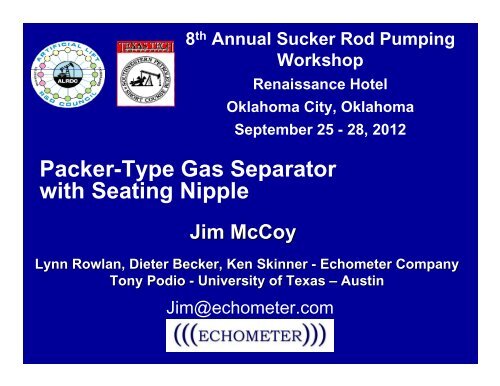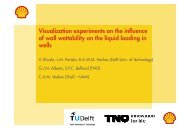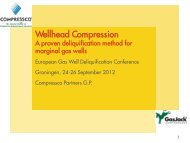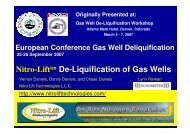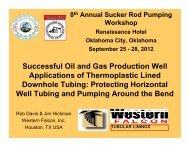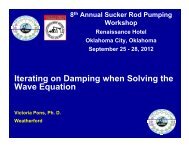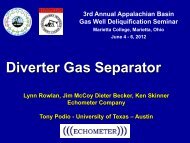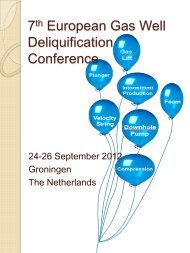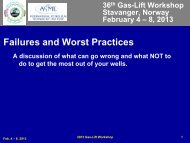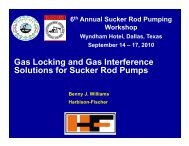Packer-Type Gas Separator with Seating Nipple - ALRDC
Packer-Type Gas Separator with Seating Nipple - ALRDC
Packer-Type Gas Separator with Seating Nipple - ALRDC
You also want an ePaper? Increase the reach of your titles
YUMPU automatically turns print PDFs into web optimized ePapers that Google loves.
8 th Annual Sucker Rod Pumping<br />
Workshop<br />
Renaissance Hotel<br />
Oklahoma City, Oklahoma<br />
September 25 - 28, 2012<br />
<strong>Packer</strong>-<strong>Type</strong> <strong>Gas</strong> <strong>Separator</strong><br />
<strong>with</strong> <strong>Seating</strong> <strong>Nipple</strong><br />
Jim McCoy<br />
Lynn Rowlan, Dieter Becker, Ken Skinner - Echometer Company<br />
Tony Podio - University of Texas – Austin<br />
Jim@echometer.com
Gravity <strong>Gas</strong> Separation from Liquid<br />
<strong>Gas</strong>/Liquid Separation<br />
is based on the<br />
principle that gas is<br />
lighter than liquid and<br />
tends to rise.<br />
•A LIQUID COLUMN<br />
HAVING AN AREA OF<br />
1 SQUARE INCH<br />
TRAVELLING AT A<br />
VELOCITY OF 6 INCHES<br />
PER SECOND IS A RATE<br />
OF APPROXIMATELY<br />
50 BPD.<br />
GAS BUBBLES FLOW UPWARD IN OIL OR WATER AT A<br />
RATE OF APPROXIMATELY 6 INCHES PER SECOND.<br />
THUS, GAS BUBBLES WILL BE RELEASED FROM LIQUID IF<br />
THE DOWNWARD LIQUID VELOCITY IS LESS THAN 6<br />
INCHES PER SECOND.<br />
Sept. 25 - 28, 2012 2012 Sucker Rod Pumping Workshop 2
Natural <strong>Gas</strong><br />
<strong>Separator</strong><br />
• The most efficient<br />
downhole gas<br />
separators locate the<br />
pump intake below the<br />
lowest gas entry point.<br />
• <strong>Gas</strong> is not pulled down<br />
to the pump<br />
perforations unless the<br />
liquid velocity is<br />
greater than 6 inches<br />
per second.<br />
• Maximum capacity is<br />
obtained using casing<br />
annulus.<br />
3
Sorry “Poor Boy” <strong>Gas</strong> <strong>Separator</strong><br />
Limited Flow Area<br />
and Small<br />
3/8 inch holes in<br />
perforated sub limit<br />
gas exit flow and<br />
liquid entry thus<br />
reducing separation<br />
efficiency<br />
Tubing Collars<br />
prevent perforated<br />
sub from laying<br />
against casing wall<br />
where liquid<br />
accumulates<br />
<strong>Seating</strong> <strong>Nipple</strong><br />
Casing<br />
Collar<br />
Perforated Sub<br />
Dip Tube<br />
Collar<br />
Joint of Tubing<br />
Sept. 25 - 28, 2012 2012 Sucker Rod Pumping Workshop 4
Collar Size <strong>Separator</strong><br />
Increases Liquid Capacity<br />
A good separator must<br />
strike a balance between<br />
annular flow area,<br />
separator flow area, dip<br />
tube diameter and<br />
pressure drop.<br />
•Outer barrel OD same as<br />
collar OD.<br />
•Thin wall outer barrel and dip<br />
tube.<br />
•Short flow conduits.<br />
•Large inlet ports.<br />
Sept. 25 - 28, 2012 2012 Sucker Rod Pumping Workshop 5
<strong>Packer</strong> <strong>Gas</strong> <strong>Separator</strong><br />
• Uses gravity separation<br />
like the “Poor Boy” except<br />
much more separation area<br />
and capacity.<br />
• Higher cost and higher risk<br />
of mechanical and sand<br />
problems.<br />
• Page Oil Tools 1957<br />
Sept. 25 - 28, 2012<br />
2012 Sucker Rod Pumping Workshop 6
Concentric <strong>Packer</strong> <strong>Gas</strong> <strong>Separator</strong><br />
A concentric packer type gas<br />
separator offers additional liquid and<br />
gas capacities.<br />
Note that the seating nipple is located<br />
immediately above the packer in this<br />
separator system.<br />
Page Oil Tools 1957<br />
Sept. 25 - 28, 2012<br />
2012 Sucker Rod Pumping Workshop 7
<strong>Gas</strong> <strong>Separator</strong> Capacity<br />
• A good <strong>Gas</strong> <strong>Separator</strong> will separate liquid from gas in<br />
the casing annulus and cause the liquid to enter the<br />
pump if sufficient liquid exists in the casing annulus.<br />
• If a well has a high fluid level and the pump is not full,<br />
the separator is not operating efficiently.<br />
• The pump is not at fault when gas is present in the<br />
pump and liquid exists in the casing annulus. Do not<br />
blame the pump. It is a separator problem and cannot<br />
be fixed by pump design.<br />
Sept. 25 - 28, 2012<br />
2012 Sucker Rod Pumping Workshop 8
Echometer Test Equipment<br />
Allows the operator<br />
to measure and<br />
analyze pressures,<br />
flow rates, liquid<br />
level depths, plunger<br />
loads and<br />
movement, casing<br />
annulus gas flow<br />
rate and other<br />
important<br />
performance factors.<br />
Wireless Equipment<br />
Sept. 25 - 28, 2012<br />
2012 Sucker Rod Pumping Workshop 11
Fluid Level Test and Analysis<br />
<strong>Packer</strong> <strong>Type</strong> <strong>Separator</strong><br />
Cobra Oil and <strong>Gas</strong><br />
Sept. 25 - 28, 2012<br />
2012 Sucker Rod Pumping Workshop<br />
12
Surface Dynagraphs and Pump Card<br />
<strong>Packer</strong> <strong>Type</strong> <strong>Separator</strong><br />
Cobra<br />
Sept. 25 - 28, 2012<br />
2012 Sucker Rod Pumping Workshop<br />
13
Typical Plunger Position and Velocity and Rate<br />
Velocity<br />
Position<br />
Maximum plunger velocity is 80<br />
inches per second and the<br />
maximum displacement rate is<br />
1258 BPD (for a 1 ½ inch plunger).<br />
A 2 3/8 inch Mechanical <strong>Seating</strong><br />
Assembly has a 0.75 inch hole for<br />
liquid and gas flow. Thus the liquid<br />
must flow through the seating<br />
nipple at a rate of 320 inches per<br />
second to fill the pump chamber as<br />
the plunger is rising.<br />
Sept. 25 - 28, 2012<br />
2012 Sucker Rod Pumping Workshop 14
13 Wells <strong>with</strong> <strong>Packer</strong> <strong>Type</strong> <strong>Separator</strong>s<br />
17 Variables were Studied<br />
Sept. 25 - 28, 2012<br />
2012 Sucker Rod Pumping Workshop 15
% liquid in <strong>Gas</strong>eous Liquid Column<br />
Vs. % Pump Fillage<br />
<strong>Packer</strong> <strong>Type</strong> <strong>Separator</strong>s<br />
Sept. 25 - 28, 2012<br />
2012 Sucker Rod Pumping Workshop<br />
16
Other Pump Fillage Factors<br />
• Variable Diameter Pump Barrel<br />
• Hole/Holes in Pump Barrel<br />
• High Clearance Plunger<br />
Lynn Rowlan Presentation<br />
These conditions will fill the pump chamber<br />
but generally lower the total production rate<br />
Sept. 25 - 28, 2012<br />
2012 Sucker Rod Pumping Workshop 17
Downhole <strong>Gas</strong> <strong>Separator</strong> <strong>with</strong><br />
<strong>Seating</strong> <strong>Nipple</strong><br />
• A new downhole gas separator for high capacity wells is<br />
offered that includes a seating nipple.<br />
• The separator is used <strong>with</strong> a packer or a flow diverter<br />
assembly or a tail pipe assembly.<br />
• The downhole gas/liquid separation occurs in the casing<br />
annulus between the casing and the outside wall of the<br />
separator.<br />
• The pump inlet is very close to the liquid in the casing<br />
annulus which results in higher pump fillage.<br />
• The tubing anchor is positioned below instead of above<br />
the separator which results in higher pump fillage.<br />
Sept. 25 - 28, 2012<br />
2012 Sucker Rod Pumping Workshop 18
Top<br />
Collar<br />
Casing<br />
Pump<br />
Formation<br />
Fluid Outlet<br />
<strong>Seating</strong> <strong>Nipple</strong><br />
Pump Inlets<br />
<strong>Gas</strong> <strong>Separator</strong><br />
Design<br />
Fluids from the formation flow<br />
upward to the gas separator and<br />
then flow through a concentric<br />
annulus to an outlet at the top of<br />
the separator which discharges on<br />
one side into the casing annulus.<br />
The gas rises and the liquid falls in<br />
the casing annulus.<br />
The pump inlet is located at the<br />
bottom of the gas separator<br />
causing the pressure drop from the<br />
liquid at the bottom of the separator<br />
to the pump inlet to be negligible.<br />
Bottom<br />
Collar<br />
Formation<br />
Fluids<br />
Diverter Cups or a packer or tail<br />
pipe <strong>with</strong> packer is located below<br />
Diverter cups or<br />
the <strong>Separator</strong> to force formation<br />
<strong>Packer</strong> or Stinger fluids into the separator.<br />
19
Top Collar<br />
Inner and Outer barrels<br />
<strong>Gas</strong> <strong>Separator</strong><br />
and<br />
<strong>Seating</strong> <strong>Nipple</strong><br />
Larger Outer barrel over seating nipple<br />
<strong>Seating</strong> <strong>Nipple</strong>, conventional or mechanical<br />
Two Large Holes for liquid flow into pump inlet<br />
Lower Collar and mating assembly<br />
2012 Sucker Rod Pumping Workshop 20
Upper<br />
Assembly<br />
The discharge port for<br />
the formation fluids is<br />
on one side of the<br />
upper portion of the<br />
separator which offers<br />
better gas/liquid<br />
separation.<br />
Sept. 25 - 28, 2012<br />
2012 Sucker Rod Pumping Workshop 21
Lower<br />
Assembly<br />
Relatively large ports<br />
exist for the formation<br />
fluids and the liquid<br />
Sept. 25 - 28, 2012<br />
2012 Sucker Rod Pumping Workshop 22
<strong>Separator</strong> Offers Increased Pump Fillage<br />
• The new high-capacity gas separator has the seating nipple<br />
installed <strong>with</strong>in the separator so that a large path of only a few<br />
inches exists between the liquid in the casing annulus and the<br />
pump inlet.<br />
• The separator is strong. The diverter cups (or packer) are<br />
mounted securely to the bottom of the separator. The tubing<br />
anchor is mounted securely to the bottom of the diverter cups or<br />
packer.<br />
• The diverter cups are strong and the elastomer is actually locked<br />
into rings on the insert.<br />
• Field tests of separator performance indicate better performance is<br />
obtained from downhole separators if the tubing anchor is located<br />
below the separator instead of above the separator.<br />
• The quieting volume size is maximized and the liquid flow paths<br />
have minimum pressure drop which result in higher pump fillage.<br />
Sept. 25 - 28, 2012<br />
2012 Sucker Rod Pumping Workshop 23
<strong>Packer</strong>-<strong>Type</strong> <strong>Separator</strong><br />
Configurations<br />
• All of the formation fluid must be directed into the<br />
bottom of the separator to pass through the separator<br />
and be discharged out of the top of the separator. Then<br />
the discharged liquid in the casing annulus falls to the<br />
pump inlet and the gas flows upward.<br />
• The flow can be directed through the separator using a:<br />
– <strong>Packer</strong><br />
– Diverter Cups<br />
– Tail Pipe <strong>with</strong> packer<br />
• All installations must have one of the diverter devices to<br />
force the formation fluids upward through the separator<br />
and out of the top of the separator.<br />
Sept. 25 - 28, 2012<br />
2012 Sucker Rod Pumping Workshop 24
Diverter Cup Assembly<br />
1. A diverter cup assembly has the advantage of being more tolerant of sand and<br />
debris problems than a packer. They are very flexible, but they require special<br />
care.<br />
2. The flexible diverter cups are mounted on a heavy wall 2.5 inch OD stainless steel<br />
tube <strong>with</strong> male connections on each end. The tube is 30 inches long and 8 cups<br />
are installed on the tube. The cups are 1 inch thick and move freely on the tube.<br />
The tube moves freely <strong>with</strong>in the diverter cups as the cups are being run into the<br />
well. Thus, when going in the hole, the cups are flexed upward, and when a joint<br />
of tubing is added to the tubing string, the cups are flexed upward and downward<br />
if the cups are not allowed to freely move on the tube. This free movement of cups<br />
on the tube prevents excessive flexing of the cups and results in longer cup life.<br />
3. The cup elastomer is bonded to an inner metal insert that slides on the 2.5 inch OD<br />
tube. The insert has metal lock rings that cause the elastomer to lock onto the<br />
metal rings.<br />
4. When running in the well, a tubing anchor is below the diverter cups which insures<br />
that large deposits or obstructions do not exist in the casing annulus which will<br />
damage the cups. Water is run into the casing annulus continuously while the<br />
separator is being run into the well to lubricate and cool the diverter cups.<br />
A packer can be used if desired. The diverter cups are offered as an option.<br />
Sept. 25 - 28, 2012<br />
2012 Sucker Rod Pumping Workshop 25
Diverter Cup Assembly<br />
Upper Male connection<br />
6 Diverter Cups<br />
Cups are loose fit to<br />
freely slide on mandrel<br />
Lower Male Connection<br />
Sept. 25 - 28, 2012<br />
2012 Sucker Rod Pumping Workshop 26
Running Sequence<br />
• The tubing anchor is run into the well first<br />
followed by the packer or diverter cups<br />
followed by the separator. Then the tubing<br />
is installed.<br />
• Important: the separator contains the<br />
pump seating nipple so another seating<br />
nipple above the separator should not be<br />
installed.<br />
Sept. 25 - 28, 2012<br />
2012 Sucker Rod Pumping Workshop 27
Tail Pipe<br />
With <strong>Packer</strong><br />
Casing<br />
Tubing<br />
<strong>Gas</strong> <strong>Separator</strong><br />
Tail Pipe<br />
<strong>Packer</strong><br />
The tail pipe <strong>with</strong> packer<br />
configuration is very<br />
effective and will<br />
increase production in a<br />
well when the pump is<br />
set a considerable<br />
distance above the<br />
formation. The tail pipe<br />
reduces the pressure<br />
required to push the<br />
formation fluids to the<br />
pump so a lower PBHP<br />
exists.<br />
Sept. 25 - 28, 2012<br />
2012 Sucker Rod Pumping Workshop 28
Tail Pipe 1000 PSI PIP<br />
Assume 3000 PSI SBHP<br />
Tail pipe increases production 27%<br />
Sept. 25 - 28, 2012<br />
2012 Sucker Rod Pumping Workshop 29
Tail Pipe 500 PSI PIP<br />
Assume 2000 psi SBHP<br />
Tail pipe will double production<br />
Sept. 25 - 28, 2012<br />
2012 Sucker Rod Pumping Workshop 30
Tail Pipe 100 PSI PIP<br />
Assume SBHP is 1000 PSI<br />
Tail Pipe will more than<br />
double production<br />
Sept. 25 - 28, 2012<br />
2012 Sucker Rod Pumping Workshop 31
Tail Pipe View 100 PSI PIP<br />
Sept. 25 - 28, 2012<br />
2012 Sucker Rod Pumping Workshop<br />
32
Final Slide<br />
This PowerPoint file is available in Echometer booth on a memory stick<br />
jim@echometer.com<br />
Sept. 25 - 28, 2012<br />
2012 Sucker Rod Pumping Workshop<br />
33
Copyright<br />
Rights to this presentation are owned by the company(ies) and/or<br />
author(s) listed on the title page. By submitting this presentation to<br />
the Sucker Rod Pumping Workshop, they grant to the Workshop,<br />
the Artificial Lift Research and Development Council (<strong>ALRDC</strong>), and<br />
the Southwestern Petroleum Short Course (SWPSC), rights to:<br />
– Display the presentation at the Workshop.<br />
– Place it on the www.alrdc.com web site, <strong>with</strong> access to the site to be as<br />
directed by the Workshop Steering Committee.<br />
– Place it on a CD for distribution and/or sale as directed by the Workshop<br />
Steering Committee.<br />
Other use of this presentation is prohibited <strong>with</strong>out the expressed<br />
written permission of the author(s). The owner company(ies) and/or<br />
author(s) may publish this material in other journals or magazines if<br />
they refer to the Sucker Rod Pumping Workshop where it was first<br />
presented.<br />
Sept. 25 - 28, 2012<br />
2012 Sucker Rod Pumping Workshop 34
Disclaimer<br />
The following disclaimer shall be included as the last page of a Technical Presentation or<br />
Continuing Education Course. A similar disclaimer is included on the front page of the Sucker Rod<br />
Pumping Web Site.<br />
The Artificial Lift Research and Development Council and its officers and trustees, and the Sucker<br />
Rod Pumping Workshop Steering Committee members, and their supporting organizations and<br />
companies (here-in-after referred to as the Sponsoring Organizations), and the author(s) of this<br />
Technical Presentation or Continuing Education Training Course and their company(ies), provide<br />
this presentation and/or training material at the Sucker Rod Pumping Workshop "as is" <strong>with</strong>out any<br />
warranty of any kind, express or implied, as to the accuracy of the information or the products or<br />
services referred to by any presenter (in so far as such warranties may be excluded under any<br />
relevant law) and these members and their companies will not be liable for unlawful actions and any<br />
losses or damage that may result from use of any presentation as a consequence of any<br />
inaccuracies in, or any omission from, the information which therein may be contained.<br />
The views, opinions, and conclusions expressed in these presentations and/or training materials<br />
are those of the author and not necessarily those of the Sponsoring Organizations. The author is<br />
solely responsible for the content of the materials.<br />
The Sponsoring Organizations cannot and do not warrant the accuracy of these documents beyond<br />
the source documents, although we do make every attempt to work from authoritative sources.<br />
The Sponsoring Organizations provide these presentations and/or training materials as a service.<br />
The Sponsoring Organizations make no representations or warranties, express or implied, <strong>with</strong><br />
respect to the presentations and/or training materials, or any part thereof, including any warrantees<br />
of title, non-infringement of copyright or patent rights of others, merchantability, or fitness or<br />
suitability for any purpose.<br />
Sept. 25 - 28, 2012<br />
2012 Sucker Rod Pumping Workshop 35


